
Magnolia is a large genus of about 210 to 340 flowering plant species in the subfamily Magnolioideae of the family Magnoliaceae. The natural range of Magnolia species is disjunct, with a main center in east and southeast Asia and a secondary center in eastern North America, Central America, the West Indies, and some species in South America.

Sparaxis is a genus of flowering plants called the harlequin flowers. It belongs to the iris family Iridaceae with about 13 species endemic to Cape Province, South Africa.

Freesia is a genus of herbaceous perennial flowering plants in the family Iridaceae, first described as a genus in 1866 by Christian Friedrich Ecklon (1886) and named after the German botanist and medical practitioner, Friedrich Freese (1795-1876). It is native to the eastern side of southern Africa, from Kenya south to South Africa, most species being found in Cape Provinces. Species of the former genus Anomatheca are now included in Freesia. The plants commonly known as "freesias", with fragrant funnel-shaped flowers, are cultivated hybrids of a number of Freesia species. Some other species are also grown as ornamental plants.

Grevillea, commonly known as spider flowers, is a genus of about 360 species of evergreen flowering plants in the family Proteaceae. Plants in the genus Grevillea are shrubs, rarely trees, with the leaves arranged alternately along the branches, the flowers zygomorphic, arranged in racemes at the ends of branchlets, and the fruit a follicle that splits down one side only, releasing one or two seeds.

Gladiolus is a genus of perennial cormous flowering plants in the iris family (Iridaceae).
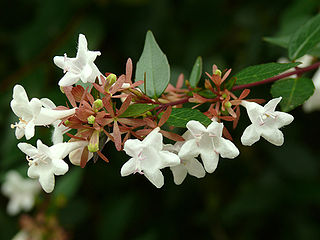
Linnaea × grandiflora, synonym Abelia × grandiflora, is a hybrid species of flowering plant in the honeysuckle family Caprifoliaceae, raised by hybridising L. chinensis with L. uniflora.
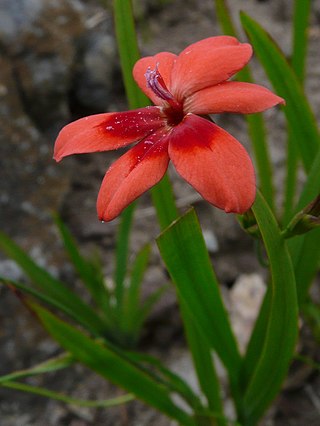
Freesia laxa, commonly known as flowering grass, is a small species of cormous flowering plant in the family Iridaceae, from eastern and southern Africa, from Kenya to northeastern South Africa. It is grown in gardens as an ornamental plant.
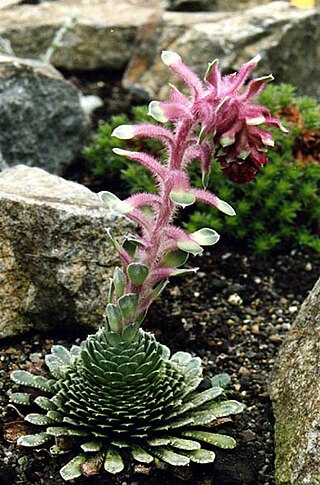
Saxifraga federici-augusti, common name Engleria saxifrage, is a herbaceous perennial plant belonging to the Saxifragaceae family. Its subspecies Saxifraga federici‑augusti subsp. grisebachii and the 'Wisley' cultivar of that subspecies have both gained the Royal Horticultural Society's Award of Garden Merit.

Sparaxis bulbifera, commonly known as harlequin flower, is a bulb-forming perennial plant. The species is native to Cape Province in South Africa and naturalised in the Azores and Australia. It grows to between 15 and 60 cm high and has white to cream flowers.

Veronica austriaca, the broadleaf speedwell, large speedwell, Austrian speedwell, or saw-leaved speedwell, is a species of flowering plant in the plantain family Plantaginaceae, native to northern temperate Europe. Growing to 90 cm (35 in) tall by 60 cm (24 in) broad, it is a mound-forming herbaceous perennial, with deeply toothed leaves and erect spikes of bright blue flowers throughout summer.
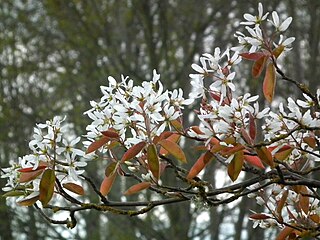
Amelanchier × grandiflora, the serviceberry, is a small deciduous flowering tree or large shrub, a hybrid of garden origin between A. arborea and A. laevis, in the family Rosaceae. It produces white flowers and small red to purple edible fruits.

Coronilla valentina, the shrubby scorpion-vetch, scorpion vetch or bastard senna, is a species of flowering plant in the genus Coronilla of the legume family Fabaceae, native to the Mediterranean Basin, and introduced into Kenya and the United States. It is an evergreen shrub growing to 80 cm (31 in) tall and wide, with pea-like foliage and fragrant, brilliant yellow flowers in spring and summer, followed by slender pods. Linnaeus observed that the flowers, remarkably fragrant in the daytime, are almost scentless at night.

Thunbergia grandiflora is an evergreen vine in the family Acanthaceae. It is native to China, India, Nepal, Bangladesh, Indochina and Myanmar and widely naturalised elsewhere. Common names include Bengal clockvine, Bengal trumpet, blue skyflower, blue thunbergia, blue trumpetvine, clockvine, skyflower and skyvine.

Allium carinatum, the keeled garlic or witch's garlic, is a bulbous perennial flowering plant in the family Amaryllidaceae. It is widespread across central and southern Europe, with some populations in Asiatic Turkey. It is cultivated in many places as an ornamental and also for its potently aromatic bulbs used as a food flavoring.

Zephyranthes minuta is a plant species very often referred to as Zephyranthes grandiflora, including in Flora of North America. The latter is, however, an illegitimate name because the original author in coining the name Zephyranthes grandiflora listed the older name Amaryllis minuta as a synonym. This makes "minuta" the acceptable epithet under the ICN. In the UK it is a recipient of the Royal Horticultural Society's Award of Garden Merit.
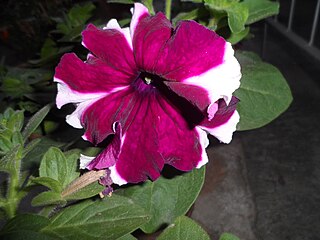
Petunia × atkinsiana is a Petunia plant "nothospecies" (hybrid), which encompasses all hybrid species of petunia between P. axillaris and P. integrifolia. Most of the petunias sold for cultivation in home gardens are this type and belong to this nothospecies.

Lachenalia ensifolia is a species of flowering plant in the genus Lachenalia, native to the Cape Provinces of South Africa. Its nominate subspecies Lachenalia ensifolia subsp. ensifolia has gained the Royal Horticultural Society's Award of Garden Merit.

Genista sagittalis, called the arrow-jointed broom and winged broom, is a species of flowering plant in the genus Genista, native to central and southern Europe, Ukraine, and Anatolia. Its subspecies Genista sagittalis subsp. delphinensis, called rock broom, has gained the Royal Horticultural Society's Award of Garden Merit.

















